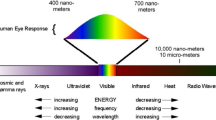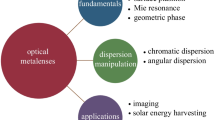Abstract
In this work, we study a simple way of controlling the emitted fields of subwavelength nanometric sources. The system studied consists of arrays of nanoparticles (NPs) embedded in optical active media. The key concept is the careful tuning of NP’s damping factors, which changes the eigenmode’s decay rates of the whole array. This inevitably leads, at long time, to a locking of relative phases and frequencies of individual localized-surfaces-plasmons (LSPs) and, thus, controls the emitted field. The amplitude of the LSP’s oscillations can be kept constant by embedding the system in optical active media. In the case of full loss compensation, this implies that not only the relative phases, but also the amplitudes of the LSPs remain fixed, leading us, additionally, to interpret the process as a new example of synchronization. The proposed approach can be used as a general way of controlling and designing the electromagnetic fields emitted by nanometric sources, which can find applications in optoelectronic, nanoscale lithography, and probing microscopy.




Similar content being viewed by others
References
Maier SA (2007) Plasmonics: fundamentals and applications. Springer, New York
Novotny L, Hecht B (2007) Principles of nano-optics. Cambridge Press, Cambridge
Coronado E, Encina E, Stefani FD (2011) Optical properties of metallic nanoparticles: manipulating light, heat and forces at the nanoscale. Nanoscale 3:4042
Halas N, Lal S, Chang W-S, Link S, Nordlander P (2011) Plasmons in strongly coupled metallic nanostructures. Chem Rev 111:3913
Ebbesen T, Genet C, Bozhevolnyi S (2008) Surface-plasmon circuitry. Phys Today 61:44
Cao Y, Wei Z, Li W, Fang A, Li H, Jiang X, Chen H, Chan CT (2013) Light amplification with low-gain material: harvesting harmonic resonance modes of surface plasmon polaritons on a magnetic meta-surface. Plasmonics 8:793
Hess O, Pendry JB, Maier SA, Oulton RF, Hamm JM, Tsakmakidis KL (2012) Active nanoplasmonic metamaterials. Nat Mater 11:573
Tao J, Wang QJ, Huang XG (2011) All-optical plasmonic switches based on coupled nano-disk cavity structures containing nonlinear material. Plasmonics 6:753
Krasavin A, Phong Vo T, Dickson W, Bolger P, Zayats A (2011) All-plasmonic modulation via stimulated emission of copropagating surface plasmon polaritons on a substrate with gain. Nano Lett 11:2231
Kottos T (2010) Optical physics: broken symmetry makes light work. Nat Phys 6:166
Wuestner S, Pusch A, Tsakmakidis KL, Hamm JM, Hess O (2010) Overcoming losses with gain in a negative refractive index metamaterial. Phys Rev Lett 127401:105
Noginov M, Zhu G, Belgrave A, Bakker R, Shalaev V, Narimanov E, Stout S, Herz E, Suteewong T, Wiesner U (2009) Demonstration of a spaser-based nanolaser. Nature 460:1110
Li Z-Y, Xia Y (2010) Metal nanoparticles with gain toward single-molecule detection by surface-enhanced Raman scattering. Nano Lett 10:243
Bergman DJ, Stockman MI (2003) Surface plasmon amplification by stimulated emission of radiation: quantum generation of coherent surface plasmons in nanosystems. Phys Rev Lett 90:027402
Stockman MI (2010) Spaser as nanoscale quantum generator and ultrafast amplifier. J Opt 12:024004
Stockman MI (2011) Spaser action, loss compensation, and stability in plasmonic systems with gain. Phys Rev Lett 106:156802
Fang A, Koschny T, Soukoulis CM (2010) Lasing in metamaterial nanostructures. J Opt 12:024013
Oulton RF, Sorger VJ, Zentgraf T, Ma R-M, Gladden C, Dai L, Bartal G, Zhang X (2009). Nature 461:629
Noginov M, Zhu G, Belgrave A, Bakker R, Shalaev V, Narimanov E, Stout S, Herz E, Suteewong T, Wiesner U (2009) Demonstration of a spaser-based nanolaser. Nature 460:1110
Hill MT et al (2009) Lasing in metal-insulator-metal sub-wavelength plasmonic waveguides. Opt Express 17:11107
Yong Suh J, Hoon Kim C, Zhou W, Huntington MD, Co DT, Wasielewski MR, Odom TW (2012) Plasmonic bowtie nanolaser arrays. Nano Lett 12:5769
Ma R-M, Yin X, Oulton RF, Sorger VJ, Zhang X (2012) Multiplexed and electrically modulated plasmon laser circuit. Nano Lett 12:5396
Wu C-Y, Kuo C-T, Wang C-Y, He C-L, Lin M-H, Ahn H, Gwo S (2011) Plasmonic green nanolaser based on a metal-oxide-semiconductor structure. Nano Lett 11:4256
Li J, Zhang Y, Mei T, Fiddy M (2010) Surface plasmon laser based on metal cavity array with two different modes. Opt Express 18:23626
Kitur JK, Podolskiy VA, Noginov MA (2011) Stimulated emission of surface plasmon polaritons in a microcylinder cavity. Phys Rev Lett 106:183903
Pikovsky A, Rosenblum M, Kurths J (2001) Synchronization: a universal concept in nonlinear sciences. Cambridge University Press, Cambridge
Hugenii C (1673) Horoloquium oscilatorium. Apud F. Muguet, Parisiis
Bustos-Marún RA, Coronado EA, Pastawski HM (2010) Buffering plasmons in nanoparticle waveguides at the virtual-localized transition. Phys Rev B 82:035434
Bustos-Marún RA, Coronado EA, Pastawski HM (2012) Excitation-transfer plasmonic nanosensors based on dynamical phase transitions. J Phys Chem C 116:18937
Brongersma ML, Hartman JW, Atwater HA (2000) Electromagnetic energy transfer and switching in nanoparticle chain arrays below the diffraction limit. Phys Rev B 62:R16356
Citrin DS (2004) Coherent excitation transport in metal-nanoparticle chains. Nano Lett 4:1561
Burin L, Cao H, Schatz GC, Ratner MA (2004) High-quality optical modes in low-dimensional arrays of nanoparticles: application to random lasers. J Opt Soc Am B 21:121
Garcia de Abajo FJ (2007) Colloquium: light scattering by particle and hole arrays. Rev Mod Phys 79:1267
Malyshev AV, Malyshev VA, Knoester J (2008) Frequency-controlled localization of optical signals in graded plasmonic chains. Nano Lett 8:2369
Jones RC (1945) A generalization of the dielectric ellipsoid problem. Phys Rev 68:93
Kelly K, Coronado EA, Zhao L, Schatz GC (2003) The optical properties of metal nanoparticles: the influence of size, shape, and dielectric environment. J Phys Chem B 107:668
Coronado EA, Schatz GC (2003) Surface plasmon broadening for arbitrary shape nanoparticles: a geometrical probability approach. J Chem Phys 119:3926
Press W, Teukolsky S, Vetterling W, Flannery B (1998) Numerical recipes in fortran 77: the art of scientific computing. Cambridge University Press, Cambridge
Rotter I (2009) A non-Hermitian Hamilton operator and the physics of open quantum systems. J Phys A Math Theor 42:153001
Gilary I, Mailybaev AA, Moiseyev N (2013) Time-asymmetric quantum-state-exchange mechanism. Phys Rev A 88:R010102
Pastawski H M (2007) Revisiting the Fermi Golden Rule: quantum dynamical phase transition as a paradigm shift. Phys B 398:278
Weinreich G (1977) Coupled piano strings. J Acoust Soc Am 62:1474
Pastawski HM, Medina E (2001) ‘Tight binding’ methods in quantum transport through molecules and small devices: from the coherent to the decoherent description. Rev Mex Fis 47s1:1
Pisignano D, Anni M, Gigli G, Cingolani R, Zavelani-Rossi M, Lanzani G, Barbarella G, Favaretto L (2002) Amplified spontaneous emission and efficient tunable laser emission from a substituted thiophene-based oligomer. Appl Phys Lett 81:3534
Carrere H, Marie X, Lombez L, Amand T (2006) Optical gain of InGaAsN/InP quantum wells for laser applications. Appl Phys Lett 89:181115
Seidel J, Grafström S, Eng L (2005) Stimulated emission of surface plasmons at the interface between a silver film and an optically pumped dye solution. Phys Rev Lett 94:177401
Noginov MA, Zhu G, Mayy M, Ritzo BA, Noginova N, Podolskiy VA (2008) Stimulated emission of surface plasmon polaritons. Phys Rev Lett 101:226806
Acknowledgments
The authors acknowledge the financial support from CONICET, SeCyT-UNC, ANPCyT, and MinCyT-Córdoba. E.A.Coronado thanks the financial support provided by CONICET PIP (2012) 112-201101-00430 and by FONCYT Program BID PICT 2012-2286.
Author information
Authors and Affiliations
Corresponding author
Appendix: Dissipative Couplings and Dynamical Phase Transitions
Appendix: Dissipative Couplings and Dynamical Phase Transitions
We mentioned that in the case of coupled piano strings, there is a dissipative coupling between the strings which can be modeled by an imaginary coupling term in the dynamical matrix 𝕄. Pure imaginary, or at least complex, couplings have interesting effects on the properties of the eigenvalues of 𝕄. At some critical values of the system’s parameters, there can be a collapse of the real part of the eigenvalues of 𝕄 and a bifurcation of their imaginary part at points called “exceptional points.” There, among other effects, 𝕄 becomes singular and the system’s eigenvectors behave oddly in their surroundings [39, 40]. Since the dynamical observables have a nonanalytic dependence on the system’s parameters, this results in what is called a dynamical phase transition, DPT [28, 29, 39, 41].
In the case of plasmonics systems, as those showed in this work, the complex coupling can be seen as just the consequence of the effective interaction between two parts of a system connected through a bridging dissipative subsystem. For example, if we have three NPs aligned, one can always calculate an effective coupling between the NPs at the ends [43]. The result of this is a complex effective coupling, consequence of the damping term of the NP in the middle [28, 29].
Figure 5 shows that the eigenvalues of 𝕄 present a collapse of their real part accompanied by a splitting of their imaginary part. Just as in the example of the coupled piano strings. This case corresponds to a very large value of the damping term of the middle NP and a mistuning parameter, δ, below a critical value. Here, it should be mentioned that what really sets the decay rates are the imaginary part of the poles, Im(ω pole), of the response function χ(ω), and not the imaginary part of the eigenvalues of 𝕄. In the wide band approximation, these last coincides with \(\text {Im} \left ( \omega _{\text {pole}}^{2} \right )\). This distinction can be quite irrelevant in some situations but becomes fundamental in others. In Fig. 6, we consider the case of two interacting NPs. We can see that although the eigenvalues of 𝕄 have exactly the same imaginary part, which would preclude the synchronization mechanism depicted in the main section of the article, there is a difference in the imaginary part of ω pole. Although this difference is very small, as compared with the case shown in Fig. 5, it is enough to give rise to a characteristic asymptotic state and, thus, it can be used to induce a phase and frequency locking. In this example, the mode with the longest lifetime will be the antisymmetric one. This, at sufficiently long times, implies that the LSPs of both NPs will end oscillating in anti-phase.
Panels a, b are, respectively, the real and imaginary part of \(\omega ^{2}_{\text {pole}}\), the eigenvalues of 𝕄; while panels b, d are, respectively, the real and imaginary part of ω pole, the poles of χ. The system consists of three aligned NPs with \(\delta =\omega _{_{\mathrm {SP1}}}^{2}-\omega _{_{\mathrm {SP3}}}^{3}\), where 1 and 3 stand for the NPs of the edges. Only nearest neighbor couplings are considered, \({\omega _{X}^{2}} = 0.2\), \(\omega _{SP}^{2}=1\) (for δ = 0), and Γ = 0.03 for all NPs except for the middle one where Γ = 0.7 (Color online)
In general, systems with dynamical phase transitions are expected to have large differences in the imaginary parts of the eigenfrequencies, as in the case of coupled piano strings or in the example shown in Fig. 5. However, phase and frequency locking is not an exclusive phenomenon of this situation. For the particular case of metallic nanoparticle arrays, the value of the damping terms needed to achieve the DPT described here are far from the realistic situation, at least for metallic NPs. Thus, the cases discussed in the main section of the article correspond to systems that do not present a DPT.
Rights and permissions
About this article
Cite this article
Bustos-Marún, R.A., Dente, A.D., Coronado, E.A. et al. Tailoring Optical Fields Emitted by Subwavelength Nanometric Sources. Plasmonics 9, 925–934 (2014). https://doi.org/10.1007/s11468-014-9698-z
Received:
Accepted:
Published:
Issue Date:
DOI: https://doi.org/10.1007/s11468-014-9698-z






